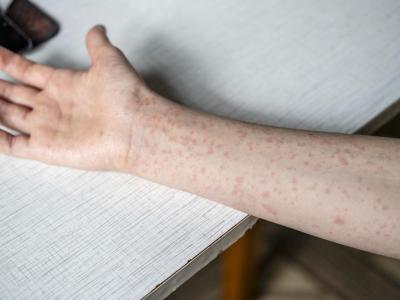P1 COVID-19 variant more transmissible, may evade cross-immunity
The P1 SARS-CoV-2 variant, which was first identified in Brazil, may be more than twice as transmissible as non-P.1 lineages, and it may lower protective immunity from non-P1 variants 21% to 46%, according to a study published yesterday in Science.
From November 2020 to January 2021, the researchers conducted genomic sequencing on 184 COVID-19 samples collected from the city of Manaus in Brazil's Amazonas state, which has experienced two major COVID-19 surges. Phylogenetic analysis showed that P1 and another lineage, P2, were descendants of lineage B1128, and that P1 probably diverged around Nov 15 after a period of faster molecular evolution. This was 3 to 4 weeks before Manaus, home to 2.2 million people, saw a COVID resurgence.
Within about 7 weeks from late 2020 to early 2021, the fraction of samples classified as P1 increased from 0% to 87%.
The P1 variant is characterized by 17 mutations, including a trio in the spike protein, which is associated with the virus' entry into the human cell. After combining genomic and mortality data, the researchers estimate that P1 may be 1.7- to 2.4-fold more transmissible than non-P1 variants, and by Feb 7, the estimated reproduction number was 0.5 for P1 and 0.1 for non-P1 lineages. P1 may also be able to evade 21% to 46% of protective immunity from previous infection with non-P1 lineages, according to the researchers.
Data from all COVID-19 samples during P1's emergence suggest the variant produces higher viral loads (with 1.43 to 1.91 lower cycle threshold values). Similarly, while mortality rates appear to be 1.2 to 1.9 times higher in association with P1's dominance, the researchers do not know how much this is because of the city's overburdened healthcare system.
"Studies to evaluate real-world vaccine efficacy in response to P.1 are urgently needed," the researchers write, adding that P1 is in more than 36 countries. "We note that neutralisation titers represent only one component of the elicited response to vaccines, and that minimal reduction of neutralisation titers relative to earlier circulating strains is not uncommon."
Apr 14 Science study
Dogs able to sniff out COVID-positive urine, saliva in pilot study
Nine dogs were able to sniff out COVID-positive urine and saliva samples in a proof-of-concept study published yesterday in PLOS One, but the researchers note that a lack of sample diversity made it difficult to tell how generalizable the training was.
Training was conducted with a scent wheel that had various scents at the end of the spokes. First the dogs were trained to detect a distinctive scent with a universal detection compound. Then they moved onto COVID-positive and -negative urine samples, all treated so the virus was inactivated, and lastly, treated saliva samples.
Across the 3 weeks of training and multiple trials, the researchers mixed positive samples from 14 children and 5 adults and used both heat- and detergent-based inactivation techniques. None of the dogs had done medical detection work prior.
During training, accuracy for heat- and detergent-treated urine was 94%, but trials introducing variables showed accuracy ranging from 11.1% to 100%, where any change in behavior was considered a reaction. The most successful rates were when dogs detected detergent-treated urine samples mixed from previous samples they had smelled before and when dogs were presented with a novel COVID-positive saliva sample and told to find another positive saliva sample. The dogs were least accurate when they tried to find heat-treated, COVID-positive urine among completely novel samples.
Excluding the trial that led to 11.1% accuracy, the cumulative accuracy was 92.5%. The researchers note that the low sensitivity rates (11% to 71%) could be partially explained by their strict definitions: Any time the dog passed by a positive sample with no reaction, it was counted as a miss.
"The training utilized in this study did not result in documented generalization of a SARS-CoV-2 positive odor profile, despite dogs showing impressive discrimination between positive and negative samples," the researchers write, noting that the dogs were able to discern individual patients over time. "This suggests that either the number of samples, or the number of sample presentations, though likely both, need to be better suited for not just discrimination but also generalization."
Apr 14 PLOS One study










